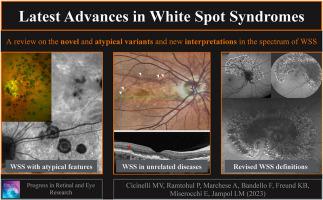Progress in Retinal and Eye Research ( IF 17.8 ) Pub Date : 2023-08-12 , DOI: 10.1016/j.preteyeres.2023.101207 Maria Vittoria Cicinelli 1 , Prithvi Ramtohul 2 , Alessandro Marchese 3 , Francesco Bandello 1 , K Bailey Freund 2 , Elisabetta Miserocchi 1 , Lee M Jampol 4

|
White spot syndromes (WSS) pose challenges in the field of ophthalmology, particularly in terms of accurate diagnosis and effective management. However, recent advancements in multimodal imaging (MMI) have significantly contributed to our understanding of WSS, allowing for improved characterization of these inflammatory chorioretinopathies. By employing various imaging modalities, including fundus fluorescein angiography, indocyanine green angiography, fundus autofluorescence, optical coherence tomography (OCT), ultra-widefield imaging, and OCT angiography, researchers and clinicians have gained valuable insights into the underlying pathophysiological changes and clinical progression of WSS.
Furthermore, MMI has unveiled novel and atypical variants within the spectrum of WSS, expanding our knowledge in this field. Notably, the identification of secondary forms of WSS occurring concurrently with unrelated chorioretinal disorders has suggested a potential autoimmune mechanism underlying these conditions. The introduction of MMI has also facilitated a more comprehensive evaluation of previously ill-defined entities, such as acute zonal occult outer retinopathy, leading to improved diagnostic criteria and enhanced recognition of distinct features. This review paper provides a comprehensive overview of the latest advances and interpretations in WSS. By integrating MMI into the diagnosis and management of these conditions, this review aims to enhance patient outcomes and provide valuable insights into the complexities surrounding WSS.
中文翻译:

白斑综合症的最新进展:新发现和解释
白斑综合征(WSS)给眼科领域带来了挑战,特别是在准确诊断和有效管理方面。然而,多模态成像(MMI) 的最新进展极大地促进了我们对 WSS 的理解,从而改善了这些炎症性脉络膜视网膜病变的表征。通过采用各种成像方式,包括眼底荧光素血管造影、吲哚菁绿血管造影、眼底自发荧光、光学相干断层扫描(OCT)、超宽视野成像和OCT血管造影,研究人员和临床医生对眼底的病理生理变化和临床进展获得了宝贵的见解。 WSS。
此外,MMI 还揭示了 WSS 范围内的新颖和非典型变体,扩展了我们在该领域的知识。值得注意的是,与不相关的脉络膜视网膜疾病同时发生的 WSS 继发性形式的鉴定表明,这些病症背后存在潜在的自身免疫机制。MMI 的引入还促进了对以前定义不明确的实体(例如急性区域性隐匿性外层视网膜病变)进行更全面的评估,从而改进了诊断标准并增强了对独特特征的识别。这篇综述文章全面概述了 WSS 的最新进展和解释。通过将 MMI 整合到这些疾病的诊断和管理中,本次综述旨在提高患者的治疗效果,并为 WSS 的复杂性提供有价值的见解。































 京公网安备 11010802027423号
京公网安备 11010802027423号